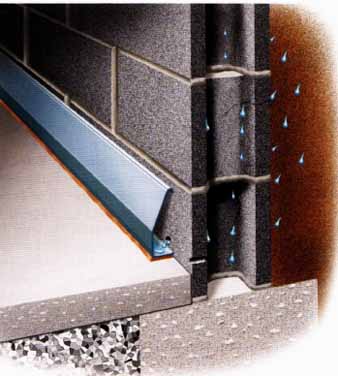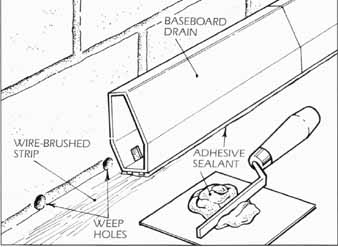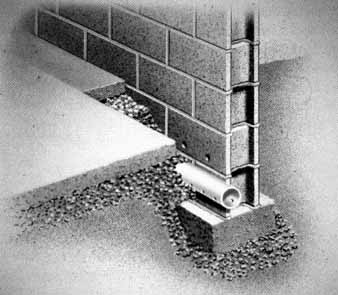Basement Water Seepage
We have a paneled, finished and furnished basement that’s being destroyed by water seep age, and I’d like to know which kind of contractor to call to fix the problem. I’ve spoken to a landscape contractor who said that dry wells will direct water away from the house. Will this correct the problem? Or should I call a general contractor for foundation work? I recently had the wall treated by a waterproofing company, but it didn’t do any good.
The contractor you should consider hiring to correct your problem is one who specializes in waterproofing basements. You don’t need a general contractor, because that person would hire a subcontractor to do the job—and you’ll be paying for the services of a middleman. But before hiring a contractor, there are a few important things you should know about water seep age into a basement.
Water can seep into a basement through the foundation walls, through the floor and through the joint between the floor and the walls. In order to correct the problem, it’s important for the homeowner to determine the location of the water entry. For example, if water is seeping in through the floor or floor joints, then water proofing the walls won’t correct the problem. Similarly, if water is seeping in through the walls, then installing a waterproofing system in the floor won’t help.
Installing dry wells won’t correct your problem unless they’re tied to drain tiles. Also, if your house is an area that has a high water table, the dry wells may not be effective during those parts of the year when the water table rises.
Based on your description of the problem, you’ll probably need either an exterior or an interior drainage system. An exterior system should have a free-flowing outlet for the drainage piping. An interior system would require a sump pit and pump.
Preventing Water Seepage
My daughter’s house has a basement that gets water in it after a heavy rain. Who do you con tact to get help? Someone suggested that a mason could put a small trench around the foundation perimeter and install a sump pump.
Before contacting anyone to have a foundation drain installed, check for a number of problems, such as clogged gutters. An overflowing gutter can cause water to seep into the basement. Rainwater should flow freely from the gutters to the downspouts, and the downspouts should direct water away from the house. Also, the ground immediately adjacent to the foundation should slope away from it, not toward it. This pre vents water from accumulating around the foundation.
If problems with gutters and downspouts are not causing the seepage, then it’s best to intercept the water before it enters the foundation. If the ground slopes toward the house, consider having a curtain drain installed in the sloped area. The drain should have a free-flowing outlet that discharges away from the house.
If sloped ground is not the problem, then water proofing the house’s foundation from the outside is your next, and best, option. However, in existing homes, the cost of temporarily relocating foundation plantings is often prohibitive, so many homeowners opt for an interior perimeter drainage system and a sump pump. In this case, the water is pumped from the pit to an outlet that's well away from the house.
A variety of contractors install interior drainage systems. One way to locate an appropriate contractor is to check your Yellow Pages or Internet for information under the heading, “Basements, Waterproofing” or “Foundation, Waterproofing.”
Baseboard Drainage System
Water leaks between the foundation wall and my basement floor. I have heard of plastic baseboards that divert this water to a sump pump. Where can I get more information on these products?
The joint between the foundation wall and the floor is a common entry point for water. Ideally, the way to correct this is to intercept or divert subsurface water before it reaches the foundation. However, if this is not practical, plastic baseboards can control the seepage.
The baseboards can be used with either poured concrete or concrete-block foundation walls. They consist of preformed hollow plastic baseboard sections, splices, inside and outside corners and endcaps. The system is secured to the concrete floor slab, adjacent to the wall joint, with an adhesive sealant that cures even under wet conditions. They are sold through hardware stores, and home centers.
Leaking Basement Wall
I have a nagging problem with water seeping into my basement after a heavy rainfall. Perforated drain pipes under the basement floor do a good job of relieving hydrostatic pressure below the slab. However, the cavities in the concrete block walls fill with water, which leaks into the basement.
Contractors recommended breaking up the floor at the perimeter and installing drain tiles and a sump pump. However, I recently heard about a plastic molding, similar to a baseboard radiator-cover, that's sealed to the inside of the foundation wall along the floor. Holes are drilled into the blocks to drain the water from the cavities into the molding, which carries it to a sump. Can you tell me more about this arrangement?


There is such a product, and it does work. But the ideal way to correct a hydrostatic leakage problem in a concrete block wall is to intercept or divert water before it reaches the foundation.
However, if you can’t lay drainage pipes because the area around the foundation is paved or covered with expensive shrubbery, or is otherwise inaccessible, then you must control the seepage into the basement. You can do this as you describe, by puncturing weep holes at the base of the concrete blocks and directing the effluent to a sump pit, where it can be pumped from the house.
The hollow vinyl baseboard units that collect wall seepage and channel it to a sump are sold at home centers and building supply outlets. Corner sections, splices and end caps are also available. In addition, you will need a special adhesive sealant that cures even under wet conditions. It should be noted that this system isn’t viable in cases where water is forced up directly through the floor by hydrostatic pressure.
Cellar Leakage
I have leakage in my cellar where the concrete-block walls meet the cellar floor. Occasionally, water will seep through the cellar floor near the block walls. I received several quotes on waterproofing, and they all use clay or bentonite injected into the ground around the exterior of the house. Some of these companies will guarantee the work they do. Is this a good procedure to follow? I hope to avoid excavating outside the foundation. Thank you for any information you can give me.

I wouldn’t recommend soil injection with a “waterproofing” material as a means of coating the foundation walls to control a water-seepage condition. To the best of my knowledge, it rarely works over the long term. Unless the foundation is exposed, you wouldn’t know if there’s anything in the ground preventing full coverage of the wall. For instance, there may be wood debris that was buried by the builder that’s now covering a portion of the wall. This debris would keep the waterproofing material from reaching the exterior foundation surface. Over the years, the wood will rot, exposing a part of the foundation wall through which water can flow. Also, if water is seeping into the house through the floor, water proofing the walls won’t correct the condition.
Since yon don’t want to resolve this problem by excavating on the outside, adjacent to the foundation, you can do it from within your cellar—provided the floor slab isn’t integral with the foundation footings. It’ll involve cutting 1-foot-deep openings within the floor slab adjacent to the problem walls, puncturing holes in the bottom blocks, installing 4-inch-diameter perforated drainpipes and gravel and then pouring concrete to match the existing floor.
The drainpipe can discharge into the sump pit and be pumped out or, if the topography around the house is sloped, the drainpipe can be pitched and run under the foundation to a low point on the exterior, which provides a free-flowing outlet.
High Water Table
I live in a rural area in Southern California that has a high water table and a lot of under ground streams. With the recent heavy rains, one of the bedrooms has flooded due to water seeping up through the house’s concrete slab. It has become a real mess. I realize that I am going to have to replace the carpeting and have considered a different type of covering such as wood parquet. Is there anything I can put on the concrete slab to seal it and prevent future occurrences?
Coating the bedroom’s concrete slab to prevent water seepage won’t provide a lasting solution to your problem. The hydrostatic pressure that develops after an extended heavy rain could lift or break the seal of paint or epoxy coating.
The best way to prevent the water seepage is to keep the level of the subsurface water below the underside of the home’s concrete slab. You can do this by installing a sump pit in the slab with a pump that's automatically actuated by water level or water pres sure. The depth of the pit should be sufficiently below the underside of the concrete slab to accommodate the pump and the associated piping and wiring. The capacity of the pump will depend on the rate at which the water table rises and may have to be determined by trial and error.
In order for a sump pump to work effectively, there should he a substantial gravel bed below the slab rather than compacted soil. With a gravel bed, water will flow readily into the sump pit when the pump is actuated, whereas with compacted soil, the water won’t flow as readily and a sump pump may not be as effective. In this case, it would be necessary to install below the slab interconnected perforated drainpipes that discharge into the sump pit. Subsurface water entering the pipes would flow to the sump pit and be pumped out.
It’s important that the pump discharge pipe terminate sufficiently far from the house so that the water won’t accumulate around the foundation. Otherwise, the water will seep into the house.
I don’t recommend covering the floor with wood parquet unless the concrete slab is 100 percent dry all year long. Even if you stop the seepage, there could be non-visible dampness at the slab surface because of capillary action drawing up the moisture below. Dampness on the underside of the wood parquet will make the flooring cup and swell, causing it to warp.